(From
American National Biography, published by Oxford University
Press, Inc., copyright 2000 American Council of Learned
Societies) — Dietmar
Schulte-Möhring
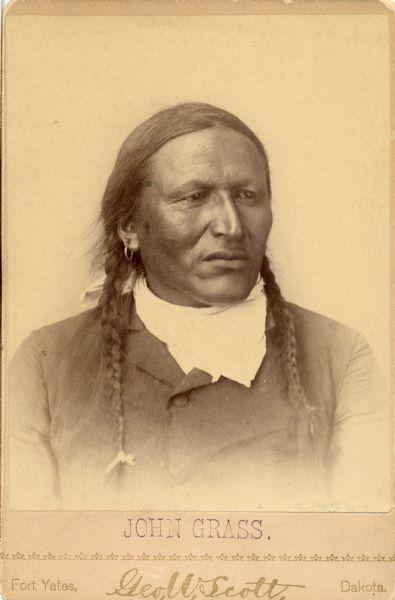
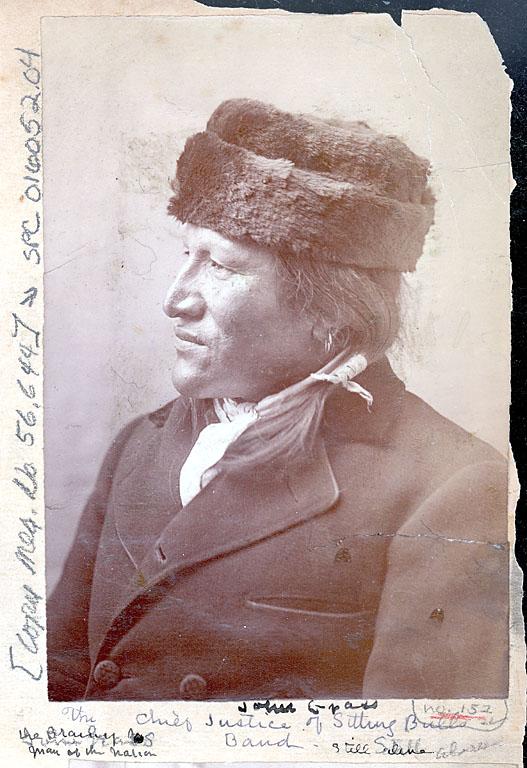
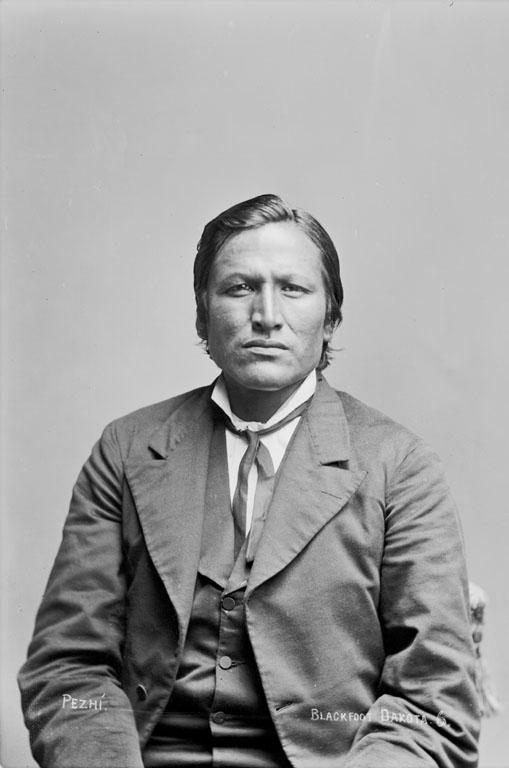
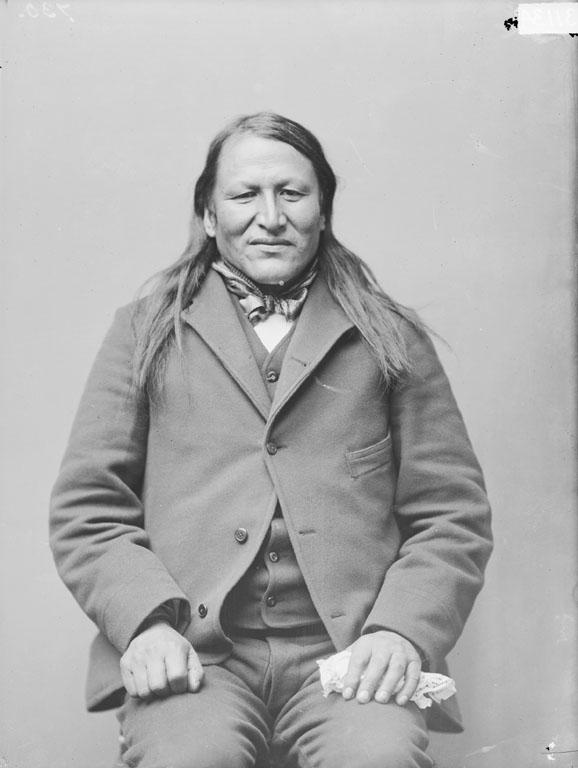
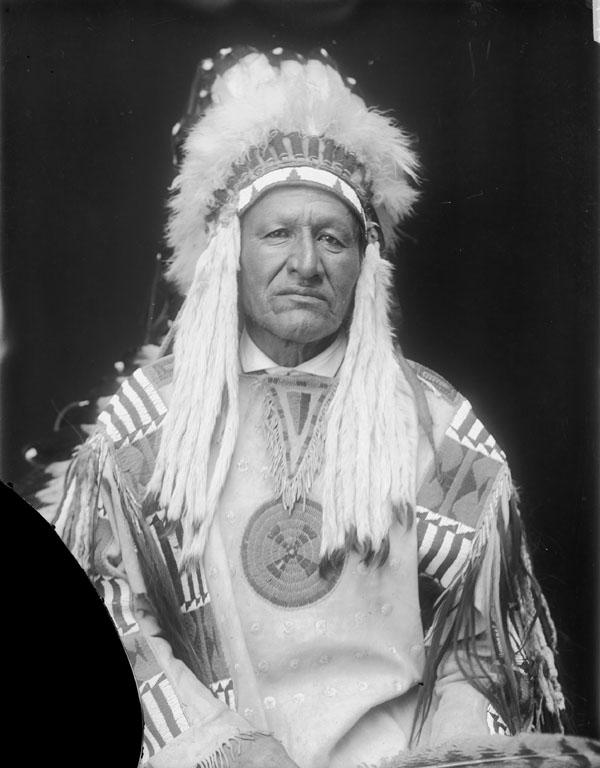
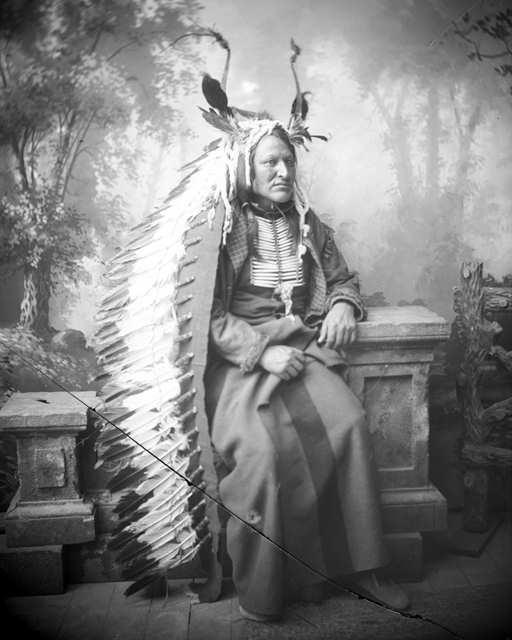
—
Dietmar Schulte-Möhring
John
Grass is an interesting and controversial figure in Sioux
history. The two most important books about the Hunkpapas
by Utley and Stanley Vestal have few good words for him.
He always seems a bit like the agent´s pet, who
was too easy persuaded to sign every treaty presented
to him.
An
agency Indian most of his adult life, Grass emerged as
[agent] McLauglin´s special favorite, the chief
spokesman for all the Standing Rock Indians. “A good talker”,
commented White Bull, “not a thinker or a smart man… could
always say yes but never no. (Utley:The Lance and the Shield)
On
the other hand, there must had been something about him.
He was an outstanding warrior in his youth and later as
a chief had a large following, dominating the Sihasapa
and was influential in all tribes at Standing Rock.
—
Dietmar Schulte-Möhring

John
Grass was a member White Horse Riders Society
Fought in the Little Big Horn
Was with at Fort Rice when Gall was stab by a bayonet
in 1965.
He was Blackfeet chief
He
says that the Blackfeet and Two Kettles always camp together.
They have intermarried with each other over the years.
Grandfather-
Sicola
Father-Uses
Him As A Shield
Charging
Bear aka John Grass
Married
Campeska Imanipiwin-Walking on Shells Woman
along with her two sisters ( Looking for their names)
Daughter
of Chief White Swan, Campeska Imanipiwin and Drags Drown
Woman.
Son of White Swan- Fine Weather
Fine
Weather's daughter married Frances Bullhead.
Mother
- Wawapilikiyewin (Many Thank you Woman)
of campeska and Drags Down Woman.
Campeska
Imanipiwin sister's is Drags Drown Woman both daughters
of Chief White Swan
Drags
Down Woman married Mato Ocinsica (Cross Bear)
Son- Makaska Najin (Standing Alone) aka John Cadotte
Sister
of John Grass is Tawaci Waste Win (Thoughtful Woman)
Son
of John Grass, Own's Spotted
Genealogy
Grass
Family as written in 1939 by A.B.Welch:
Grandfather
Sicola (Barefooted) Chief
Grandmother Wihusta Win (Lame Woman)
Father
Wacanka yapi (Uses Shield)
Mother Wawapi lakiyewin (Many Thank you Woman)
Father’s
2nd wife Mahipyanta Keyeta Kewin
(Goes to Heaven and Sits on CloudWoman)
Father’s 3rd wife Wiciqa (Little Woman)
Wiciqa
Family Gilbert Cadotte (in U.S.Navy)
John Cadotte (Standing Alone) at Wakpala
Ben Cadotte at Mowbridge
Mrs. Hoehner at Wakpala
Mrs. Nick Cadotte (Makaska Najin)
Tawaci Waste win
(Kind Heart Woman)
John
Grass sisters
Pijuta Sapawin (Black Medicine Woman)
married
Belden and married John Darling, a timber contractor (Chakaska,
Wood chopper).
Ite
ywintapi win (Gracious Face Make woman),
Belden wanted her...she married a
Hunkpapa named Kaptan yan (Turn Over).
Oglala
Win … given by Oglalas … single.
Auntie
Cross (Oyuhpewin … Drags Down Woman) is 84 years old,
lives in South Lemon, married to Louis Cross (Mato Ocin
sica...Cross Bear) who paid one horse and one gun for
her.
Ite
Wakan win (Holy Face Woman) married Noel Burshia,
2 children died.
John
Grass brothers
Hehaka
ite waste (Good Face Elk),
nicknames Siowipi (Body Carrier),
Postah (Load).
Married Sicangu (1st wife)
2nd wife Ina Kampeska imanipiwin
(Walking
White Buffalo)
a Minneconjou Tlek sila Waste
Waniyacekapi (Jerked Him Arrow).
John
Grass has an unpublished bio by AB Welch.
We have just gotten this history return to the tribe.
— LaDonna Brave Bull
Allard
Charging
Bear or John Grass was born on the Grand River about 1837.
He was the son of the older Charging Bear, Chief of the
Sihasapa or Blackfeet band and his mother was the daughter
of a chief of the Oohenopa or Two Kettle band of the Teton
Sioux. Prior to the death of the older Charging Bear,
which took place late in the 1870’s, the son was looked
upon as the worthy successor by the Blackfeet. Though,
up to this time he had acted in a subordinate position
to his father, he already had gained enviable reputation
among his people for wisdom in council and for his ability
as a orator.
During
the exciting and turbulent period among the Dakotahs from
1876 to 1880, he opposed contention with the Government
on the ground of expediency and the best interests of
his people. Though his bravery was not questioned by them,
he frequently incurred the enmity of the warlike element
by his able and often effectual opposition to the more
warlike chiefs.
Like
Spotted Tail, he felt that war with the Government was
folly, that the Indians were not strong or numerous enough
to contend with the whites, that the inevitable results
would be greater suffering and hardships and, if long
continued, the final defeat, if not the entire annihilation
of his race. He argued that since the game was gone the
Indians, of necessity, would be compelled to change their
mode of living, and by council and peaceful measures instead
of war, the Government would finally recognize their rights.
He opposed any further disposition of the Indian lands
and advised his people to retain their remaining possessions
and use them for grazing purposes, and should they desire
to sell any portion of them, to demand of the Government
a compensation equivalent to their real value.
He
became the leader of the peace element of the northern
Sioux and, when joined by Gall and his people in 1881,
his position became fixed as the leading exponent of progress
among his people. In this position he was earnestly supported
by Gall who, though differing with him in his earlier
careers, was ever his life-long friend.
In the attempt of the Government in 1888 to secure the
consent of the Indians to cede their lands between the
White and Cheyenne rivers and east of the 103rd degree
of latitude, it was thought best to come first to Standing
Rock and induce such leaders as Grass and Gall to agree
to the terms presented by the Commission in the hope that
his might favorably influence the Indians at other Agencies.
The
Indians in their preliminary councils had chosen the Chiefs
John Grass, Gall, Mad Bear and Big Head to represent them
before the council with the Government representatives.
The Commissioners, finding these chiefs unyielding in
their opposition to the terms offered, undertook to break
the power of these chiefs with their tribe.
— LaDonna Brave Bull
Allard
John
Cadotte writes a strange, disjointed letter to Welch,
March 26, 1940:
Col.
A.B.Welch, Matowatakpe
My Dear Cousin Tankansi
Te Anpetu ake wowapi cicukta
I am going to write to you today again. First we all well
and getting along fine and Auntie Cross she is well and
she had to be out at where one of my daughter’s farm and
ranch about 1½ mile from town northwest for a while
to visit them. But before she left from here where she
stay with my sister Mrs. R.L.Hoehner, we were talk over
about this great father, Sicola or Sicolamani, also his
nick name was Herekawicasta, that means Old Man. He was
a great Chief of Sihasapa’s tribe of the Sioux’s. Also
he was a medicine man and what they call Miracle Man.
Well our great grandfather Sicolaun or Sicola, he was
a real Sihasapa Blackfeet Chief so he was always in where
they make treaties with the other Chief. This other's
Chiefs they are all in One Sioux’s Nations or Tribes but
they are all have what they call Bands. This Sioux’s Band’s
have one Chief in their band, or they have two Chiefs
in their bands. Some have three chief’s in their band’s,
where they are little more people in their bands and they
all have named to it in their bands. So this Sicolaun
or Sicolamani or Hereawicasa, he was a chief in the Blackfeet’s
bands. And this Lone Horn or Hewanjca, he was Oglala or
Hunkpapa’s chief of band’s. Also Pipe or Canupa he was
Rosebud Chief of bands. And Young Elk or Herakacinca he
was chief of the Two Kettle’s and Minikowapi bands. And
Grass, he was a great chief of the Blackfeet’s Sioux’s
tribes of their days, especially, of course when the great
Sioux, of Indians, when they are going to make agreements
of treaty, they have to invited each other for together,
so they have to talk over their matters or their business.
So that is why all this chief’s meet at one place to signed
the treaty’s with some of their own band’s, where they
meet together.
Sicolaun
or Grass’ first son was John Grass or Wakacankayapi (Peji)
No. 1, next John Grass or Matowatakpe No. 2. John Grass
or Gliskaynka No. 3 was Albert Grass’ father. Well, Uncle
John Grass (Matowatakpe) he was never in the Gen. Custer’s
fight at all. He was down to along the Missouri river
south below the Fort Pierre and round where the Cheyenne
Agency now stand. Also at the mouth of Moreau river below
where Four Bear’s camp and up here at where the Old Agency
use to be mouth of Oak Creek or Grand river. Usually when
the Agency here move up to Fort Yates in North Dak he
was still here too. Never go any other place. They all
in South Dakota all the time till they all died. This
Sicolaun or Herekawicasa, Chief Sioux of Blackfeet’s they
are all stay for a while down below Fort Pierre in South
Dakota when he was old age that time so I think he died
down there at that place also was burial down there too
where they called little bend and Big Bend. Sicolaun or
Herakawicasa, he was the one that have he’s people of
the Blackfeet’s bands make them to carried to his own
great tepee’s by his own nice Buffalo Robe to Father DeSmet’s
up here along this Oak Creek from here where we are now
living Wakpala, four miles north of here. There’s where
the Blackfeet’s Sioux’s of bands are camping big circle
that time. Well Tanhansi, when you come over we want to
see you for good and I might you some more things about
our Uncle Matowatakpe also Sicolaun and others Chief’s.
So we sure very anxious you to come and see you and see
us. We are send to you our best wishes and regards to
you.
Yours respectfully, John Cadotte, Sr.
Makoskaunaji
— LaDonna Brave Bull
Allard
Amanda,
or Cecilia Grass, was known as Shell Woman, Red Cloth
and Mrs. John Grass. The only marriage contracted by this
decedent was that to John Grass, to whom she was first
married by Indian custom about the year 1874 and later,
by ceremony, with whom she lived until his death on May
10, 1918. By him she was the mother of several children
all of whom died at early ages and without issue.
This
fixes the date of at least two of Grass’ marriages, since
he married these sisters on the same day. We do not know
about the first one. But Eagle Horn said Grass had several
wives, he, however, could only remember 5. How is that
for your Ate? And his children? They were everywhere,
he said, spreading his fingers. Now, Senor, this is almost
too much. But think we had better stick to the admitted
records.
Amanda
Grass was the daughter of Chief White Swan and Blue Thunder.
Her brothers were John Fine Feather; William White Swan
or Puts on His Shoes; White Swan (who died and the older
brother took his name). Sisters were: Red Buffalo Woman,
Unnamed child who died when young, Wasula, a half sister.
There were others who died many years before without issue.
John
Grass, Jr. died in 1910. His mother was Little Eagle (This
must have been another name for Cecilia Grass’ sister.
For you remember that your relatives said he married two
sisters the same day. Then the above paragraph showing
the brothers aznd sisters of Mrs. Grass, does not give
this name). Eagle Horn says he was buried as the old Indians
were, although the young Indians wanted a military funeral,
such as all soldiers are given. He was buried with his
horse and gun.
Albert
Grass was the son of John Grass, Jr. and Annie Two Bears
was the mother.
— LaDonna Brave Bull
Allard
Grass
talks about ancestors, about 1915:
Chief
Grass told me that he could count many grandfathers; that
they had borne the name of Mato Watakpe or Charging Bear,
because it was a good name and through their works had
now become famous in Indian History. He had always remembered
that his name was Mato Watakpe, and so had tried to live
right and not bring dishonor to the name and thus to his
father’s fame and memory.
Grass
talks about his Father, 1915:
Chief
Grass said to me, “My grandfather was born somewhere in
Nebraska. The time those men fought the Rees with the
soldiers was about 91 years ago (Blue Thunder Count 1831-32
“Below Fort Yates above Grande river, Mandan Gros Ventre
and Ree had a village, a double one there. Soldiers and
Dakotah attacked village. Eight Dakotah dilled. Soldier
French and Dakotah”). My grandfather was one of the leaders
in that time. I got my name by fighting the Rees when
I was seventeen years old. My grandfather gave me his
name with a dog feast and the sun dance was made then.”
Welch
note: He also told me that the Hunkpapas came into this
prairie country about ninety five years before.
Cloud
Bear talks to Welch, undated:
“Chief
John Grass’ own father’s name was Wahacankayapi (Shields
All...also Peji or Grass). Grass’ grandfather was Oglala
Teton. I do not think his name was Mato Watakpe.”
Fire
Heart talks, undated:
His
mother was a sister of Chief Grass’ father (Oglala) so
these two noted old Dakotah men are blood cousins. He
said Grass’ father and grandfather were both great chiefs
and that Grass was too.
Red
Tomahawk note, undated:
Red
Tomahawk’s grandmother and Grass’ grandmother were sisters
Other Children of Uses Him as a Shield, continued:
Pejuta Sapawin (Black Medicine Woman) was another daughter
of Uses Him as a Shield and one of his wives. She married
a white man named John Dailing, who was a cordwood contractor
for steamboats along the Missouri river. His name among
the Lakota was Chakaska (Wood Chopper). She also married
another white man, a Lieutenant of the U.S.Army. by the
name of Belden.
Iteywintapiwin
(Gracious Face Woman … this is a hard name to translate)
It was given to her in commemoration of an episode of
her father, who, having dragged a Crow woman from her
horse in a fight in Montana, was going to kill her, when
that woman made the sign of greatest thanks across his
face and down his body with her two hands, and named some
of his relatives. This saved her life. This Crow woman
was desired by Lieut. Belden, but did he not arouse her
romantic desires, and she married a Hunkpapa named Kaptanyan
(Turn over). Belden then married Gracious Face Woman.
Oglalawin
(Oglala Woman) was another daughter. Her name was given
by their close tribesmen. She died single.
Oyuhpewin
(Drags Down Woman). Name given from an incident in which
her father pulled an enemy from his horse in a fight.
She was born in the vicinity of the present Lemon, S.D.,
at White Clay Butte, while her people were on a buffalo
hunt - in 1855. Her own statement was that she was 84
winters. According to the Hunkpapa Winter Count, this
was the winter when “A White Man named White Beard held
the Indians in camp all winter at Pierre.” Drags Down
Woman married Louis Cross, whose Sioux name was Mato Ocinsica
(Cross Bear) and sometimes called Sanica (On One Side).
He was a Sihasapa. He paid her father one horse and one
gun for her, in the custom of the Sioux at that time.
She was present at this interview, has a keen mind and
a store of historical events in mind, which she freely
related to me. She is quite well-known among her relatives
as Auntie Cross; has a typical, creased, but kindly, face
and, at the gathering for the dance that evening, made
speech regarding her famous brother, Chief John Grass,
making the statement that, “he was the friend and protector
of the whites, always.”
Ite
Wakanwin (Holy Face Woman) was another daughter of Uses
Him as a Shield. She married Noel Burchia (unknown to
me) and they had two children, both of whom died in infancy.
Hoksila
(Good Boy) was another son of Uses Him as a Shield, long
since dead, without issue living.
— LaDonna Brave Bull
Allard
Other
Children of Uses Him as a Shield, continued:
Waniyocekapi
(Jerked with Arrows) was another son. He received his
name from a war incident, in a running fight with the
Toka (enemy) which was probably a Crow Indian. This fight
and flight was of four days duration, during which he
was shot with several arrows which could not be immediately
removed, and they jerked him severely before they had
an opportunity to cut them out. Several Sioux women were
captured and kept by the Crows in this fight. Drags Down
Woman told us that that was the reason why there were
some good people among the Crows - descendants of these
captured Sioux women prisoners.
Uses
Him as a Shield was the father of two other children,
both of whom died in infancy.
Chief
John Grass (Pezhi), also called Mato Watakpe (Charging
Bear) and Siyowipi (Full of Prairie Chicken) married three
women as follows:
The
first wife was a woman of the Sicangu (Brules or Burnt
Thighs), a tribe of the Tetonwanna or Tinton (People of
the Prairie) Dakota. Little is known of her, except that
“she went away.”
The
second plural wife was Ptesanmaniwin (White Cow Woman
Walking).
The
third plural wife was named Kampeskaimanipewin (Walking
the Shell Woman). She was the sister of White Cow Walking
Woman and they were daughters of a famous Miniconjou Chief
named Mga Ska (White Swan). They were taken at the same
time by Chief Grass - White Cow Woman Walking being but
seven years of age at that time. This little girl never
knew that she was the wife of John Grass until one day,
she was told to accompany her husband for Fort Pierre,
with pack horses loaded with buffalo hides dressed for
the St. Louis trade. Walking on the Shell Woman was the
only wife known to the writer, and was called Ina (Mother)
by him.
Children
of Chief John Grass ...four boys (only one of which is
mentioned herein):
Hoksila Waste (Good Boy) who married a woman from among
the Yanktonaise. This woman gave birth to a son whose
Sioux name was Hehaka Mani (Walking Elk) and called, by
the whites, Albert Grass. He enlisted in the World War
(WWI) as a volunteer, under the wrtier, A.B.Welch, who
was the commanding officer of Co. “A”, 1st N.D.N.Guard.
This regiment was reorganized and combined with the 2nd
N.D.N.G. to make a war-strength regiment known as the
164th Inf., and which was made a replacement, mainly to
the 1st Div., and, in action at Soissons, France, in June
1918, Hehaka Mani was killed in action in the wheat fields
there; buried where he fell. After the war, his body was
disinterred, returned to the Cannon Ball river, and buried
in the Catholic Cemetery at Cannon Ball Station, North
Dakota. His mother, after the death of her husband, married
the grandson of the famous Yanktonaise Sioux named Mato
Nopa (Two Bears). She still lives. Her name is Anne Two
Bears.
Children of Chief John, continued:
Chief
John Grass and Ina (Walking on the Shell Woman) had several
other children, all dying or being killed in early youth.
Among these was a set of twin girls of which they were
exceedingly proud. They were named Wacinyanpi Win (Faith
Woman) and Wacatkiyapi Win (Charity Woman). Both died
in early childhood.
More Comments by Leo Cadotte, talking to Welch at Mandan,
September 6, 1943:
“We
can trace our family far back. We have made a study of
this thing.
“It
is a kind of tradition that the Grass family was started
by Oompah, which means Moose. They got it wrong in the
archives (i.e. Treaties) and the clerk put it down as
Big Deer. Maybe that’s the way the interpreter said -
that it was a big deer.
“Then
his son was Tatonka tonka (Big Buffalo); that was a very
long time ago.
“Then
came Sicolau, which means Barefooted.
“Sicolau’s
son was Uses Him as a Shield.
“Grass
(Pezhi) known also as Charging Bear, was the son of Uses
Him as a Shield.
“Grass
had a son named Many Spotted (Horses), whose son was Albert
Grass, known to the Indians as Hehaka Mani (Walking Elk),
who was a soldier who volunteered under Capt. A.B.Welch
in the N.D. 163-164th Infantry for the first World War
and was killed in action at Soissons, France, 1918.
“War
Eagle in the Air was also a relative and is frequently
confused with another Indian named High Eagle. But they
are two different men, although the names are spelled
identical. They kept them apart with nick-names, so they
would know which man they meant. War Eagle in the Air
was known as Big Rim or Thick Seam (like in the edges
of cloth when it is turned back and sewed).
“Another
relative of Chief John Grass was the Oohenopa (Two Kettle)
named Black Moon. Auntie Cross says that he and John Grass
were cousins by blood. These Two Kettles and the Blackfeet
were closely related and nearly always camped together
and took part in each other’s undertakings.
“Another
Two Kettle relative by blood of John Grass was the influential
man named Tall Mandan.”
— LaDonna Brave Bull
Allard
Notes
on John Grass, as given by some of the Sihasapa who knew
him, Wakpala, S.D., May 5 and 6, 1941:
Bird
Flying Over (Swiftly) was Lame Woman’s name (she was the
wife of Sicola).
Used
as a Shield had eight wives.
Two
Packs was also called Hawk Shield. He was Herbert Welch’s
father. Mary Pleets is a half-sister of Herbert Welch
Tall
Mandan is an uncle of Mrs. Theresa Cross. He was Sihasapa.
Leo
Cadotte says, that at Washington (Indian Bureau Department),
Indians are still considered ‘hostile’ if they had relatives
in the Custer Battle
John
Grass ‘sold’ his sisters so they would live a long time.
He ‘sold’ Drags Down Woman to Cross Bear, who was a medicine
man.
John
Grass went to Oklahoma (The Indian Territory) to look
over the land when the Government wanted to send all the
Indians there. He reported that our Dakotas could not
live there.
White
Cloud (or, End of Cloud)’s mother was a first cousin of
John Grass’ mother
The
Calf Robe Pipe was brought to the Indians before Columbus
touched the shores of the American Continent.
Good
Voice Bull is a first cousin to Mrs. Theresa Cross. Thomas
Good Voice Bull (his son) is still living.
Sitting
in the Sky Woman would not sell her allotment. Had heard
her husband say there would be many whites, and that land
would be needed. She saved it for her children.
Sitting
in the Sky Woman sewed the clothes that Fanny Kelly, the
white captive, wore when she was taken by the Indians
to Fort Sully in the winter of 1864….Dresses, leggings,
moccasins, robes. This was in the lodge of Used as a Shield.
The
Sihasapa think the picture of Barefoot with the three
other Sioux was taken in 1864 at the Black Hills Treaty.
They will find out. (Note: picture was apparently never
in Welch’s possession).
— LaDonna Brave Bull
Allard
Welch
and Angela Boleyn interview Leo Cadotte (son of Grass’
sister), Mandan, N.D., September 6th 1943:
(Angela
Boleyn was a writer-friend of Welch creating a life story
about John Grass .. but, cannot locate this ‘book’)
Now
this is what I want to talk about: You have said that
Chief John Grass was the man who planned the campaign
when they killed those men in Montana (W-This refers to
the Custer affair). You are writing a book about our relative
Grass. He has told you what part he played in that. I
have talked with many people, old ones, who knew. They
always denied that thing. But you know.
Now
they think that they are placing John Grass in a bad position
before you. They say: “He (Welch) has the truth now. If
he has the truth, and does not tell it - what is the use
of having it if he cannot tell it.” That was a long time
ago; the archives cannot be changed now; We think that
it is time to tell it now. It cannot hurt anyone now.
The claims we have against the Government will be put
off from time to time anyhow. Auntie Cross is very old
and will die pretty soon. She wanted Charging Bear to
know but was afraid of punishment by the Government. She
wanted to tell him (W-Welch) but was fearful of consequences.
etc., etc.
Cadotte
continued: So I believe it is all right for you to write
it. The truth cannot hurt now. The archives have the Sihasapa
as a ‘peaceful Teton tribe.’ Too much has been written
and is now in the archives and they will remain that way.
Asked
about details, he continued: The Oohenopa (Two Kettles)
and the Sihasapa were together there. They nearly always
camped together. Black Moon was with them - he was Headman
of the Brave Hearts (Police). (W-the Brave Hearts was
the largest of the Soldier Societies, and there were members
in every tribe of the Tetons and even in the Isanti Division
of the Dakota). Tall Mandan was also a Head Man of the
Brave Hearts and was with the camp. They broke camp down
somewhere along the Padani Wakpe (W-Grand river - meaning
the River of the Arikara on account of their villages
being at the mouth of that river) and went west into the
valleys of the rivers flowing northward into the Hehaka
Wakpe (W-Elk river, as they called the Yellowstone).
Before
this time, General Custer had seen Grass and some other
powerful men and wanted them to go with him into Montana
country. Chief Grass told him like this: ‘You have smoked
with me You have said that as long as water flows there
will be peace between us. Therefore, you will not need
me with you because you are going in peace. You have Padani
Scouts with you who know the trails that way.’
Welch and Angela Boleyn interview Leo Cadotte (son of
Grass’ sister), Mandan, N.D., September 6th 1943:
But,
he could not believe that Custer would take so many soldiers
with him if he was really going in peace. He did not want
to be identified with a war expedition against his own
people. When they broke camp they moved west to be out
there. We believe that Grass laid out the general plan
to congregate in the valley of the Greasy Grass. (W-This
is the Big Country). Crazy Horse was a young man. He could
not have made the plan or he would have kept away from
Gen. Crook. No one ever said that Sitting Bull laid out
the plan. Gall was doing just what Sitting Bull wanted
him to do. Therefore, Gall did not do it. It was not Black
Moon because he was not a Chief, but a Head Man of the
Soldiers Society. Then came the battle. Crazy Horse obtained
much notoriety because he was where Custer came into the
valley and started for the ford. Gall was fighting at
the south end of the village and did not reach the Custer
ground until the battle was almost over. Sitting Bull
did not fight.
After
the battle Chief Grass went back fast to the Grande River.
Tall Mandan probably went with him because he appeared
there too. You ask who Scabby Head was and I cannot tell
you because I do not know. Black Moon talked much after
that and it is said that he was a great warrior at that
fight. The old people never did call him Scabby Head.
But the Sihasapa, nearly every young man among them, were
there together with the Two Kettle fighting men. Their
camp was about in the middle there. They probably fought
with those of Crazy Horse. As the camps came in, they
extended the camp line from Sitting Bull’s camp toward
the north - so Chief Grass’ Sihasapa and Two Kettle must
have appeared there and camped about the third in line
toward the north. Crazy Horse’s band must have come in
at the about the same time as the Cheyenne, and camped
at the far north. (W-This seems logical according to the
‘map’ made by One Bull which shows the arrangement of
the camps just before Custer struck them. It also agrees
with the map made for me by Red Fish, a hostile Yanktonaise
Chief, who made a mark on it and said ‘Chief Grass sat
here.’ This last mentioned map shows the Council held
after they had left the battlefield as troops started
up the Big Horn after ferrying across the Yellowstone).
During
this long conversation, Cadotte said several times, that
he thought it would be all right now to tell the truth
about it, and that it should be written by Mato Watakpe
(Welch) and Mrs. Boleyn.
Excerpt from Angela Boleyn letter to Welch, referring
to the foregoing conversation:
...Most
interesting about Tall Mandan and Black Moon. But I think
Scabby Head was Grass. A name he took or thought up at
the moment he needed one, for Leo said it was not Black
Moon. So Grass must have said something like this, ‘Say
Scabby Head was in charge of the Sihasapa.’ Yes? and we
have the story of the chiefs who smoked with Custer before
he went after Sitting Bull and his hostiles and which
culminated in the Custer Battle.
Welch interview with Grass, c. 1915:
Some
one has said this: ‘We think of the Indian as of a mysterious,
stern, unforgiving, dim silhouette upon a hill; the grey
light of a departing day and setting sun in the west shows
their shadow for a moment and they are gone.’
They
who said that were almost right. But with our back burdened
with the labors and griefs of a people just emerging into
the light of hope; when we who reasoned deeply could see
a better way than the superstitious and blind wanderings
of the past; just as we could begin to see a grand future
for our people and our loved Nation, we were rushed, too
fast for us to understand, over the top of the grey hill
spoken of and into the disturbed shadows of the dim lighted
‘beyond.’
But
I do not answer you. In the presence of my son, Mato Watakpe,
I speak what is in my mind. He told me you were a great
friend of ours, so I speak to you as to him. Those were
all great men I told you about. Red Cloud was perhaps
the greatest. Gall was the second one. I, who am chief
today, have problems as great as they had then. I am through.
Tomorrow I will speak again. Hao.
— LaDonna Brave Bull
Allard

Here's
a Bell photo of Gall and Grass from 1888.
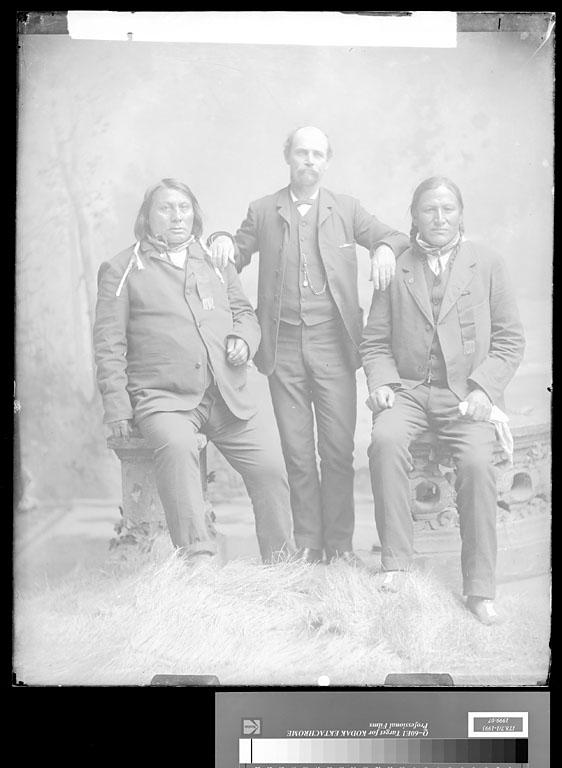
Seeing
it, makes me wonder about the dates of the photos Dietmar
posted. Interestingly, he looks youngest in the third
photo down (by Bell) from 1880 if the SIRIS info is right;
he seems to have grown his hair long after this period
through the 80s, at a time when you'd expect the reverse
to be the case. I post the Gilbert photo which I'm guessing
comes from the mid 80s, later than Dietmar's Scott photo.
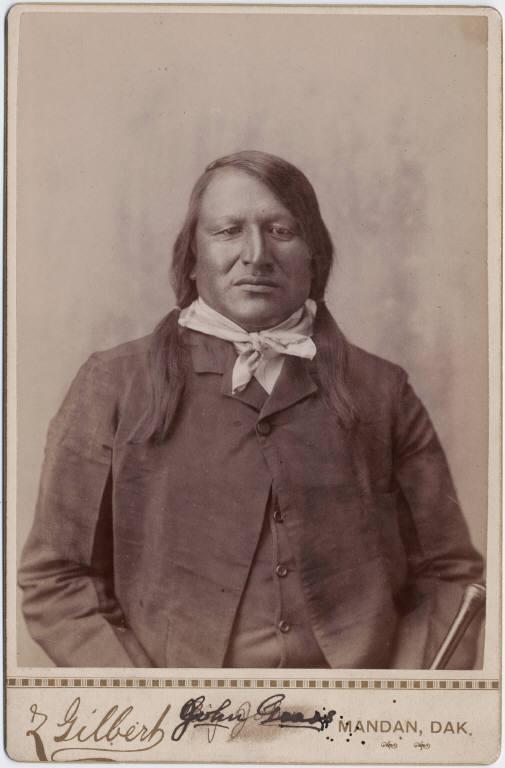
—
Grahame Wood

I
know that Welch understood Grass was at the Little Bighorn,
but I have some doubts about it. If he was, he must have
come in to Standing Rock immediately afterward (as one
of the sources above suggests). This certainly deserves
some more study. — Ephriam
Dickson

It
is said that he return the same time as Kills Eagle. —
LaDonna Brave Bull Allard

To the
Commissioner of Indian Affairs
Washington, D.C.
Sir:
I have the honor to state that on my assuming control
of this Agency, I immediately called a council of the
chiefs, and from 30 to 40 of the principal ones responded
thereto. I told them that their Agent, Mr. Burke, had
been relieved, and that I had been detailed as their Agent.
I gave them to fully understand that the "Great Father"
was very kindly disposed towards all peaceable Indians,
and that I was directed by him to do everything in my
power for their protection and comfort. I told them that
he was angry with the young men that had gone off to the
Hostile Camp to fight his soldiers, and that I had been
directed to say to them that all these young men must
come into the Agency, lay down their arms and surrender
themselves to the Military Authority.
After
I had completed what I had to say to them, "John
Grass," the leading chief of the "Black Feet,"
and one who has a number of young men out with the hostiles,
spoke about as follows: -- "That his young men would
not come in and be arrested by the military; that they
would not be slaves; that he had never had anybody talk
to him before as I had done; that he was a great chief
and could stand up and look any one in the face; that
he had expected soft words; that he did not believe that
the "Great Father" had sent any such word; that
if he had, his young men would not come in; that they
would go to Cheyenne [River] Agency where they would receive
better treatment; that he had heard from there that the
young men that had been out with the hostiles and had
come in and laid down their arms had been given traionts
and were allowed to go where they pleased, and that they
had not been made slaves."
...
R.
E. Johnston
Captain 1st Infantry
Acting U.S. Indian Agent
—
Ephriam Dickson

I
think I remember that John Grass should be in this photograph,
taken around 1890 by Trager, Morledge or some other.
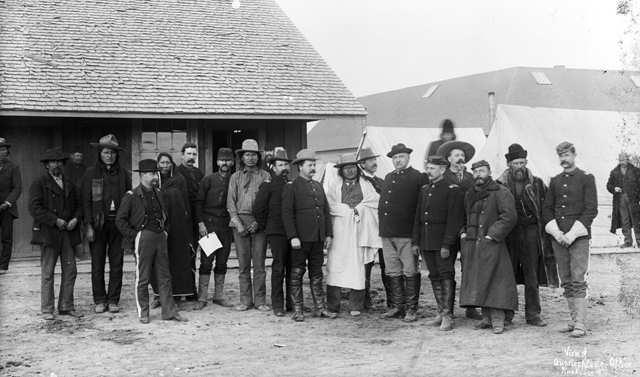
If
he is (the photo must have been made at Pine Ridge!),
he must be the man standing second from left with big
hat. American Horse, Young-Man-Afraid and Bill Cody are
also in the photo. —
Dietmar Schulte-Möhring
Here's
another article about John Grass with a photo I haven't
seen before: https://sdexcellence.org/Chief_John_Grass_1978
Chief
John Grass from Standing Rock Reservation
Inducted in 1978
Category: Indian Heritage
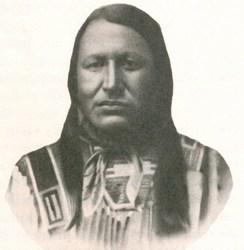
DOB:
1837
POB: Along the Grand River, SD
DOD: 1918
Buried at: Ft. Yates, ND
Chief
John Grass was born in 1837 near the Grand River in South
Dakota. He became Chief of the Blackfoot Sioux. The surname
Grass was dynastic and was born by his father and grandfather,
both of whom were with the Sioux allies in the expedition
under Colonel Henry Leavenworth against the Arikaras in
1823.
Young
Grass was baptized and received into the Roman Catholic
Church, according to tradition. Early in life he distinguished
himself in battle; and at seventeen, for exploits performed
against the Crows and the Mandans, he received his warrior
name, Mato Watakpe (Charging Bear) which also had been
born by his ancestors. About the same time, to prove his
endurance, he underwent the extreme ordeal of the sun
dance.
Although
Chief Grass was later to become one of the leading exponents
of a peace policy, he probably took part in some of the
conflicts with the whites in the 1850's and 1860's.
Fanny
Wiggins Kelly, in an account of her captivity among the
Sioux in 1864, mentions Chief Grass as Jumping Bear. She
gratefully credits him with having saved her life on one
occasion and with having subsequently aided in effecting
her ransom.
In
his youth Grass became noted as an orator, and in the
agitation against the whites during the early 1870's,
he made full use of his powers. He strongly opposed war,
which he declared would be ruinous, and urged upon his
people the necessity of gradually abandoning the chase
for more settled occupations.
Though
Chief Grass' counsels for the time went unheeded, after
the conflict of 1876-77 his prestige returned. A few years
later, with Gall, the former chief at his side, Grass
became a dominant influence among the Sioux.
At
Fort Yates on the Standing Rock Agency Chief Grass served
for many years as Chief Justice of the Court of Indian
Offenses, an office that he held until his death. He also
took part in many treaty councils with the whites, stoutly
defending the rights of his people. As an Indian Commissioner
at the Council of 1888, relating to the cession of certain
lands in the present South Dakota, Grass brought the proceedings
to a close when it appeared that the government commissioners
were seeking an unfair advantage.
A
new commission, headed by Charles Foster, former governor
of Ohio, offered more favorable terms the following year.
Grass, though for a time demanding further reconsessions,
in the end encouraged his people to accept the proposed
treaty.
When
the U.S. entered World War I, Grass advised the young
men to enlist. His grandson, Albert Grass, was killed
at Soissons, one of the first of the American Expeditionary
Force to fall in battle.
Chief
John Grass died after a winter’s illness at his home south
of Fort Yates and was buried in the local Catholic cemetery.
— Dietmar Schulte-Möhring